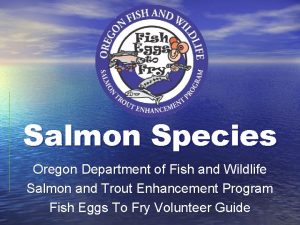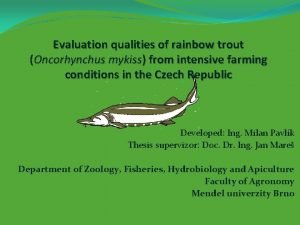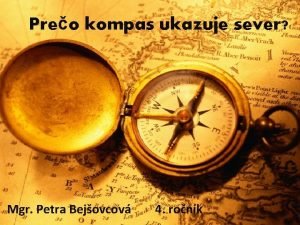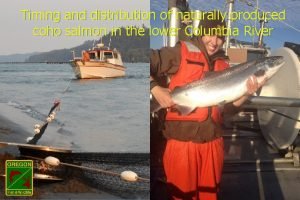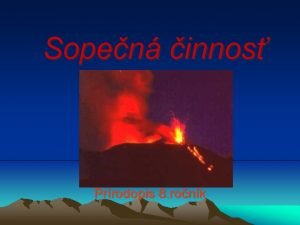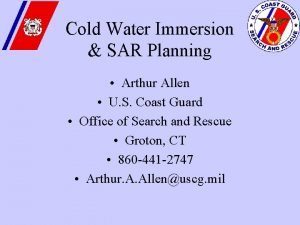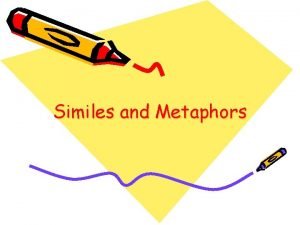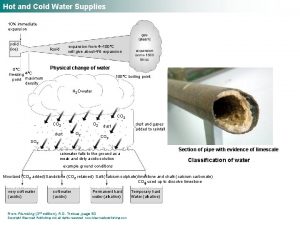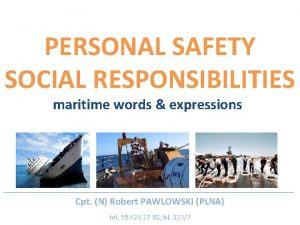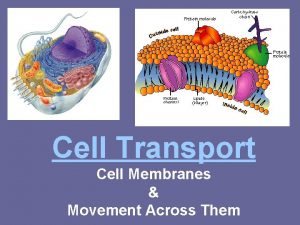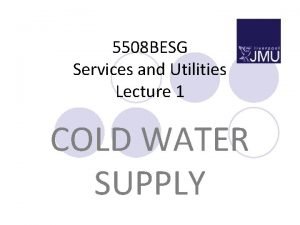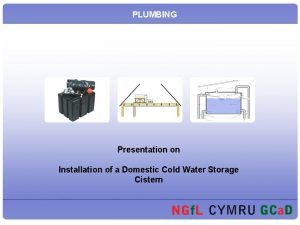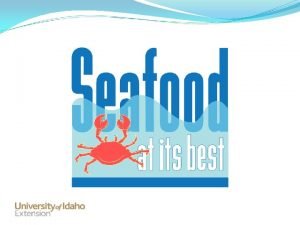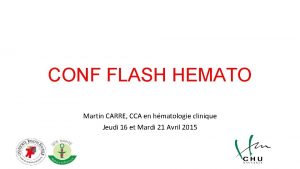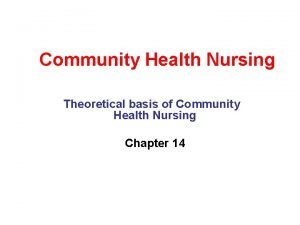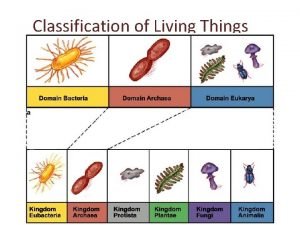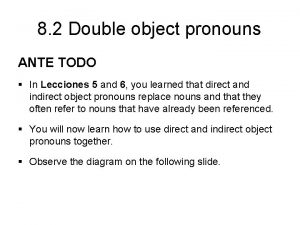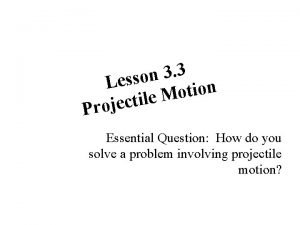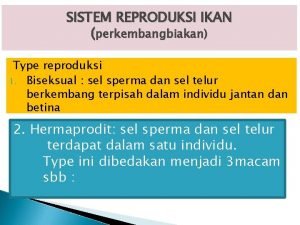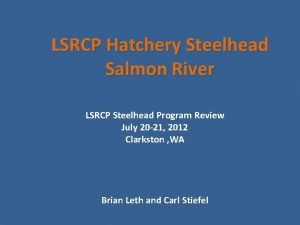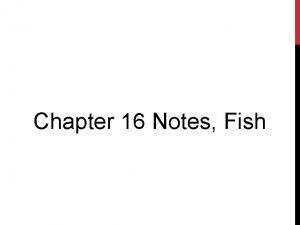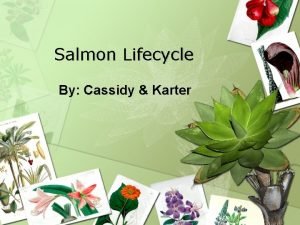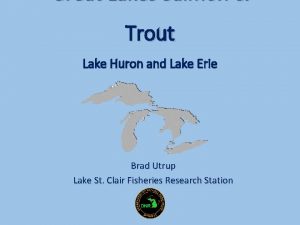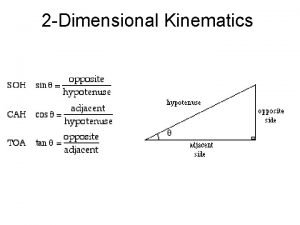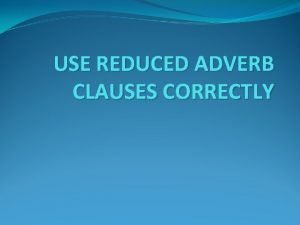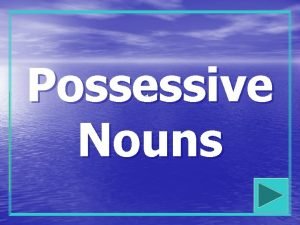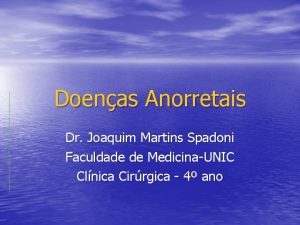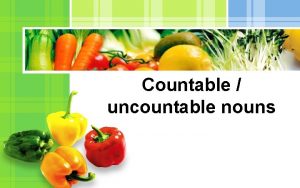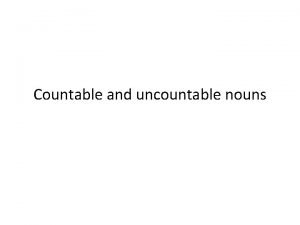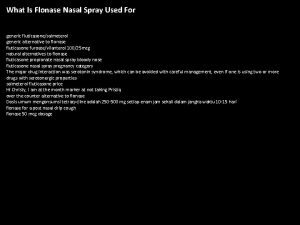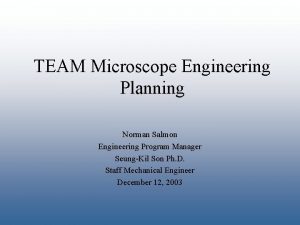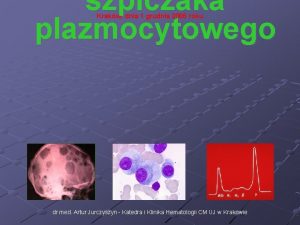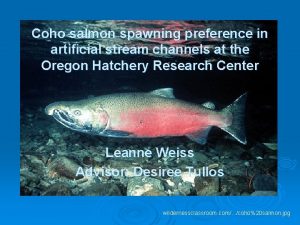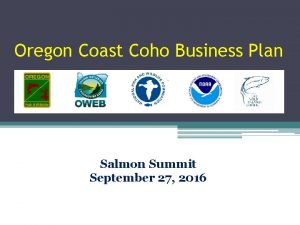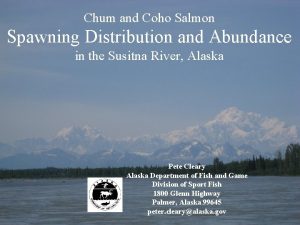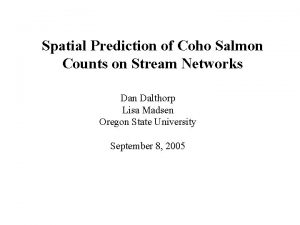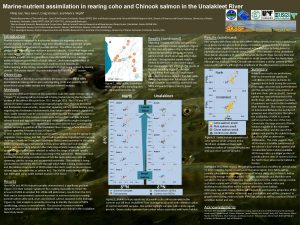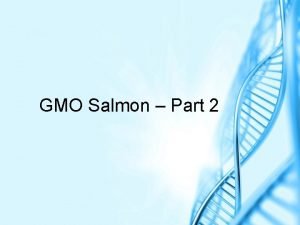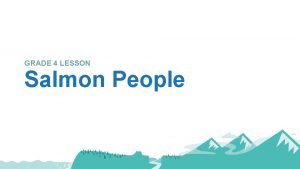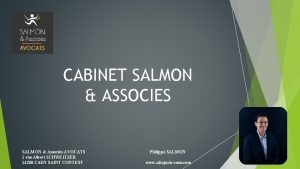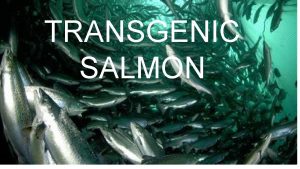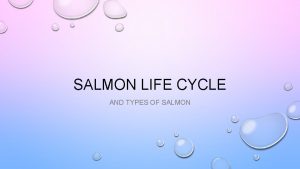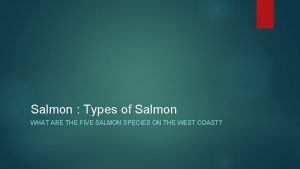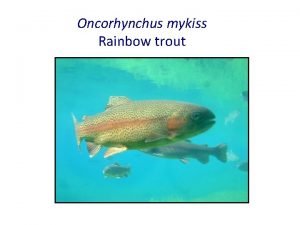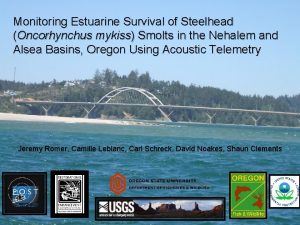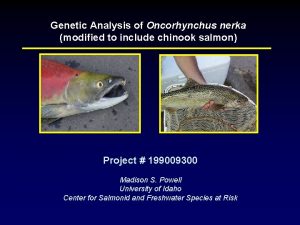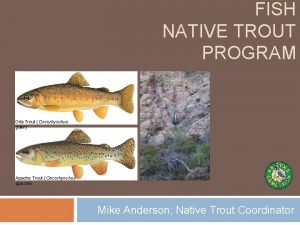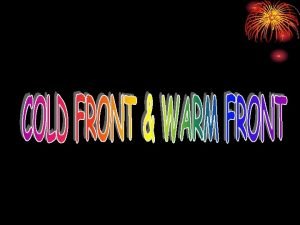SALMON Salmonidae Coho Salmon Oncorhynchus kisutch Cold water























































- Slides: 55

SALMON

Salmonidae

Coho Salmon Oncorhynchus kisutch • • Cold water 65 degrees Anadromous Carnivorous

Home Range • From pacific coast line to Russian and Japan Coast line • Grow rapidly second year when feeding on other fish.

Chum Salmon Oncorhynchus Keta

Chum Salmon Oncorhynchus Keta • • Deeper body Cold temperatures Widest distribution Hatchery techs developed in Japan. • Migrate the furthest

Chinook Salmon Oncorhynchus tshawytscha • Chinook Salmon Oncorhynchus tshawytscha. Oncorhynchus- greek onkos meaning barb and rhynchos meaning snout. Russian word for чавыча

Chinook Salmon Oncorhynchus tshawytscha • 40 lbs largest salmon. Also known as King salmon, spring salmon, Tyee salmon • Similar to coho salmon except for large size and small black spots on both lobes of tail. • Junvenile spend 3 months to 2 years in freshwater before migrating to estuarine areas as smolts and then into the oceans to feed and mature. • They remain for 2 to 4 years

Sockeye Salmon Oncorhynchus nerka

Sockeye Salmon Oncorhynchus nerka

Sockeye Salmon Oncorhynchus nerka • Also known as kokanee salmon, blueback salmon. • Northern Pacific Ocean. • Oncorhynchus- greek onkos meaning barb and rhynchos meaning snout. Nerka is the Russian name for anadromous form. • Native American work Suk-Kegh sockeye meaning red fish.

Steelhead Oncorhynchus Mykiss

Steelhead • Steelhead is not salmon. It is a type of trout. • Unlike a salmon that dies after spawning, steelhead trout can spawn, and return to ocean and migrate back upstream to spawn several times.

Euryhaline and Anadromous • Euryhaline- able to tolerate a wide range of salinity • Anadromous- migrating up rivers from the sea to spawn

How? • Kidneys have to drop their urine production • Molecular pumps in cells of gills shift into reverse pumping sodium out instead of in.

Salmon • Atlantic salmon, Salmo salar, are a native freshwater fish species. • Salmon begin their life in freshwater but spend a year or more in the sea before returning to freshwater to spawn.

Why is it important to have healthy salmon stocks? • Biodiversity • Angling • Tourism

The lifecycle of salmon Q: What is a life cycle? A: “The life cycle or life history of a living thing is the series of changes it goes through from the beginning of its life until death. ”

Life cycle of salmon

Spawning • Spawning is undertaken in the autumn and winter as water temperatures fall. • Spawning takes place where the river bed is made up of small stones and pebbles and is silt free. • The water must be unpolluted. • The eggs are deposited in a ‘redd’ which the female fish cuts in the river bed with her tail. Once the eggs are in the redd she covers them over so they are buried out of sight.

The egg stage • Salmon produce up to 1700 eggs per kg of body weight (a kg is about the same weight as a bag of sugar). • Prior to hatching you can see the fish’s eyes within the egg – the eggs are then described as ‘eyed ova’. • The time taken to hatch depends on the water temperature – the colder the water the longer the eggs take to hatch.

The egg stage • Sometimes eggs do not survive to hatching and turn white and die. • Can you see the dead eggs in the photo opposite?

The alevin stage • When the eggs hatch the young salmon are called ‘alevins’. • Alevins do not look for food as they feed from their yolk sac. • To avoid predation and to save energy they remain buried in the river bed. • Once they use up their yolk sac they move into the water above to search for food.

Fry and parr stages • For the first year of their life the young salmon are called ‘fry’. • Once they are over a year old they are known as ‘parr’. • Salmon feed mostly on aquatic invertebrates in freshwater but they can also feed on terrestrial insects that fall into the water. • The salmon fry and parr are dark coloured to help hide them from predators.

Smolts • Young salmon stay in their home rivers until they develop into smolts. This process is dependent upon water temperatures and food availability. • In southern parts salmon may leave home after 1 year but in northern areas they may take 5 years! • The ‘smolt run’ when these fish migrate downstream into the sea is around April. May.

Where do smolts go? • Smolts swim along the coast in shoals and then move into feeding grounds. • They head north towards the cold waters of the Arctic. • Smolts that remain in the sea for one winter are called grilse and they feed around the Faroes. • Some smolts travel to feed in waters off Greenland. These salmon will stay at sea for two or three winters.


Adult salmon head • This is the head of a large male salmon just prior to spawning time. • It has developed a ‘kype’ on it’s lower jaw. Q: What do you think this is for ? A: It is used as a weapon to fight with other male salmon to see who spawns with the best females!

What happens to salmon after they spawn? • After salmon have spawned they are weak and tired. They also look thin. • They are then known as ‘kelts’. • About 90 -95% of kelts die after spawning. The others may survive to spawn 2 to 4 times. SPAWNING

How do people study salmon populations?

Electro-fishing • Electro-fishing is used to stun the fish so they can be captured without harming them. • Using electro-fishing equipment all the fish can be captured in a known area. • This allows the number, growth rates and health of the fish population to be examined.

Fish tagging • Fish are often tagged to help in experiments and studies. • The fish in the top photo is having a tag injected under the skin near its eye. This does not harm the fish but means that biologists can recognise it in later years. • Can you see the yellow tag beside the fish’s eye?

Testing water quality • Clean, well-oxygenated water is needed for healthy salmon. • By testing a sample it is possible to examine if the water is polluted. • The equipment in the photo was set up to test the water’s acidity, as acidic conditions can stop salmon from hatching. It is powered by a solar panel.

Fish traps • Fish traps are often used to capture fish entering burns to spawn. This allows biologists to assess whether enough fish have returned to the river.

Scale reading

What problems face the salmon?

Pollution problems • Severe pollution will kill fish. • Large amounts of silt entering a river may suffocate eggs and alevins buried under the gravel. • Even if pollution does not kill the fish it may kill the invertebrates which salmon feed on leaving them to starve.

Access to spawning grounds • If salmon are not able to get to where they’d like to spawn, their whole lifecycle may suffer.

Parasites and disease • Parasites and disease may kill large numbers of fish, in particular when fish congregate in high densities below falls or at the mouth of a river. • This photo shows a sea louse on a salmon that was caught by a netsman. These parasites can cause problems to both juvenile and adult salmon.

Question Q: What problems can these animals pose to salmon? A: Erosion Bank collapse Lack of cover Silt input

Question Who could have eaten this fish?

Answer A Seal!

Otter kill • This fish was killed by an otter. • Although it had only eaten a small part of this fish when the photo was taken the otter actually returned the following 3 days until it had devoured the lot!

Can you think of any other problems that salmon might face?

How can people help salmon?

Deciduous tree planting • If few natural deciduous trees exist near the water courses then it may be desirable to plant more. • The trees will: – Provide shelter & cover – Stabilise bank sides – Increase number of invertebrates = More & bigger salmon!

Bank side fencing • The erection of fencing to keep farm animals away from the water edge is beneficial. • As you can see in the photo, a fence has been erected so that bankside vegetation can recover from overgrazing.

Fish passes around obstructions • Fish passes can be created to allow salmon access to suitable spawning areas upstream. • Fish ladder

Poor instream habitat • In this watercourse, the farmer had dredged and straightened the burn over a number of years. He did this to make it easy for water to drain quickly away from his fields. • The burn was not suitable for salmon any more as spawning beds were silted up and little suitable habitat for parr existed. • It was felt that something had to be done!

Better instream habitat • This is the same burn after tonnes of rocks were carefully added by hand. • The careful addition of rocks actually helps the water to drain away quickly! • The little weirs and dams that were created provide more suitable salmon habitat. • A far healthier salmon population is now found in this burn.

Stocking • To help salmon survive in areas where spawning is a problem, some groups undertake stocking. • Stocking involves rearing salmon eggs in a hatchery until they reach fry or parr stage. • The reared fish are fed until they are returned to the wild. • Survival rates are higher in the hatchery than in the wild

Aquaculture and Salmon Why are Atlantic Salmon raised in the Pacific NW? Since 1951 they have been bred to become easier ot farm and they are more domesticated than other salmon fish species. More resistant to disease and is docile

What is Salmon farming? • Open net-cages


Freshwater Hatchery • Broodstock moved to freshwater tanks or cages in autumn about 2 months before stripping • Eggs stripped dry and fertilised with milt, then water disinfected.
 Where do salmon live
Where do salmon live Oncorhynchus mykiss
Oncorhynchus mykiss Trout anatomy diagram
Trout anatomy diagram Water and water and water water
Water and water and water water Warm water rises in a lake. cold water descends.
Warm water rises in a lake. cold water descends. Z čoho sa skladá počítač
Z čoho sa skladá počítač Hlska
Hlska Z coho sa sklada pc
Z coho sa sklada pc Z čoho sa skladá kompas
Z čoho sa skladá kompas Genitv
Genitv čím sa líši vyparovanie od varu
čím sa líši vyparovanie od varu Pacemaker coho
Pacemaker coho žiarovka a jej objavenie
žiarovka a jej objavenie Z coho sa sklada sopka
Z coho sa sklada sopka The cold war begins lesson 1
The cold war begins lesson 1 Disadvantages of direct cold water supply
Disadvantages of direct cold water supply Cold shock
Cold shock Magnesium with cold water
Magnesium with cold water Similes about summer
Similes about summer Direct system of hot water supply
Direct system of hot water supply Sarsat
Sarsat Crichex
Crichex Indirect cold water system
Indirect cold water system Cold water storage cistern diagram
Cold water storage cistern diagram Shkollat e shekullit 21
Shkollat e shekullit 21 Trout vs. salmon
Trout vs. salmon Score iss myélome
Score iss myélome Dr douglas salmon
Dr douglas salmon Salmon et durie
Salmon et durie Ahc hemato
Ahc hemato Salmon white’s construct for public health nursing
Salmon white’s construct for public health nursing Lizzy salmon peoria il
Lizzy salmon peoria il How to write scientific name
How to write scientific name Intentalo el salmon la duena me
Intentalo el salmon la duena me Salmon often jump waterfalls to reach
Salmon often jump waterfalls to reach Partenogenesis terjadi pada hewan
Partenogenesis terjadi pada hewan What to serve with salmon
What to serve with salmon Pedigree salmon
Pedigree salmon Salmon patch
Salmon patch Salmon life cycle
Salmon life cycle Do salmon eat plankton
Do salmon eat plankton Salmon çoğul hali
Salmon çoğul hali The sun was salmon and hazy in the west figure of speech
The sun was salmon and hazy in the west figure of speech Salmon trout lake
Salmon trout lake Salmon often jump waterfalls to reach
Salmon often jump waterfalls to reach Reduced adverb clauses
Reduced adverb clauses Salmon brother
Salmon brother Possessive of octopus
Possessive of octopus Regra goodsall salmon
Regra goodsall salmon Salmon countable or uncountable
Salmon countable or uncountable Pot is countable or uncountable
Pot is countable or uncountable Calcitonin salmon coupon
Calcitonin salmon coupon Norman salmon
Norman salmon Durie salmon
Durie salmon Sean salmon medtronic salary
Sean salmon medtronic salary Salmon patches
Salmon patches
